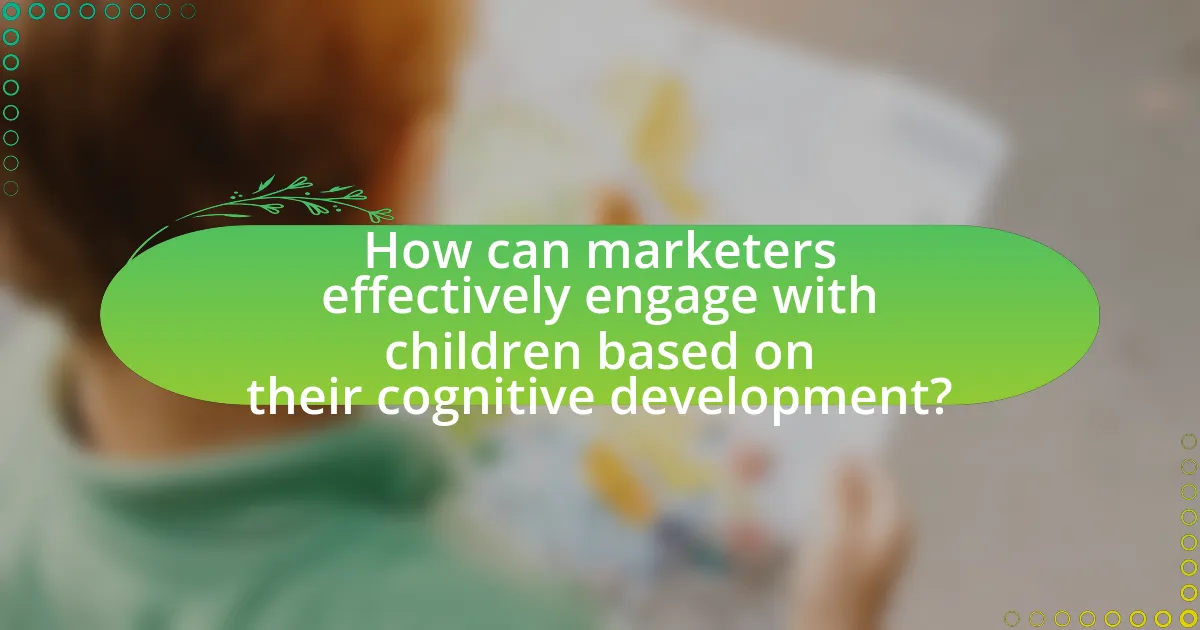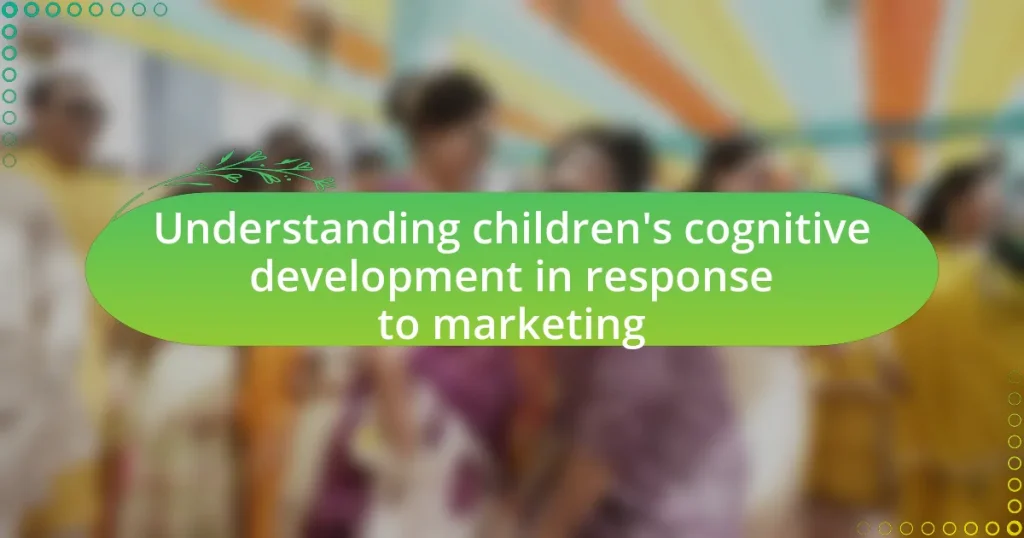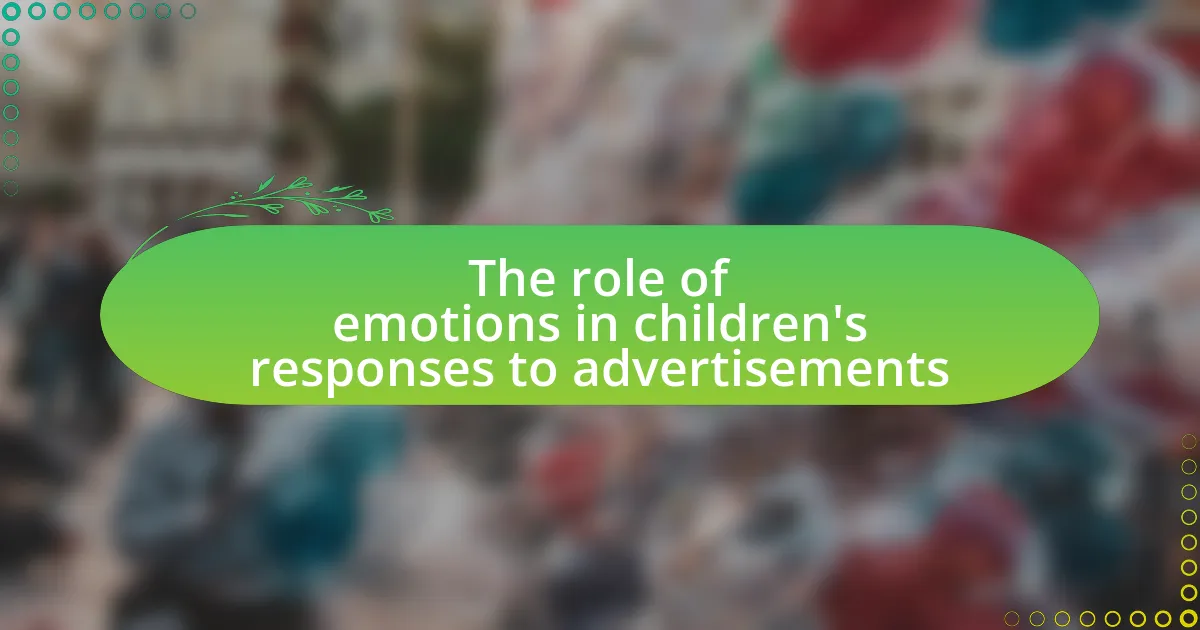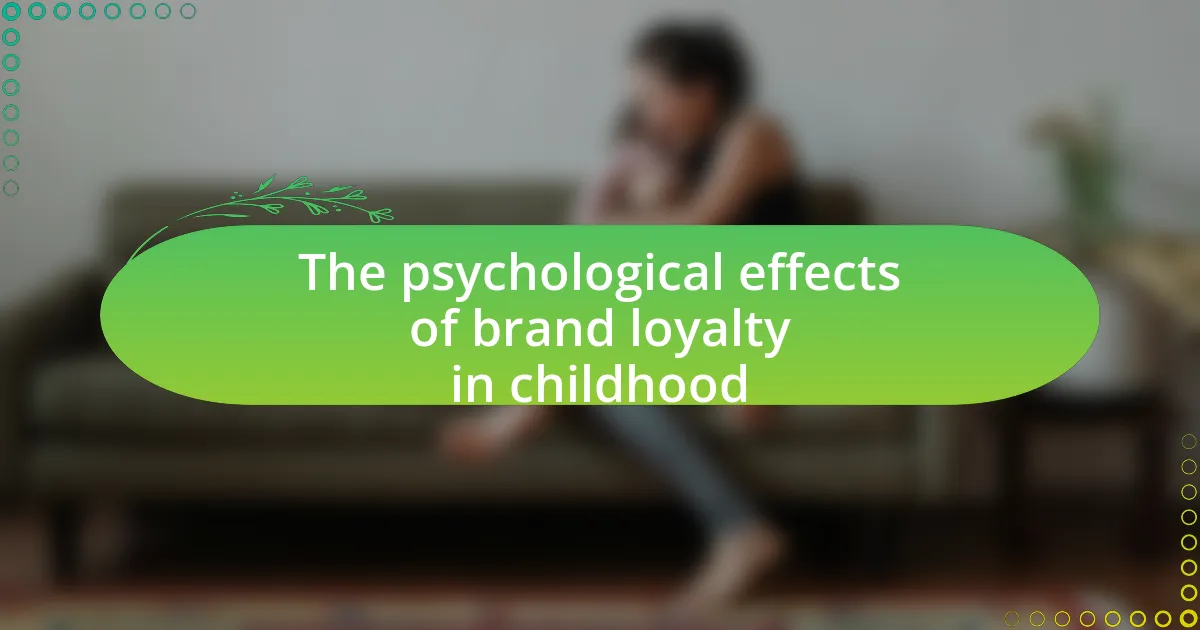The article focuses on children’s cognitive development in response to marketing, examining how their understanding and processing of advertising messages evolve with age. It outlines key stages of cognitive development based on Jean Piaget’s theory, highlighting how children’s abilities to recognize brand logos, comprehend persuasive intent, and critically evaluate marketing content progress from early childhood through adolescence. The article also discusses the significant influence of marketing on children’s decision-making processes, the role of parental guidance in shaping their responses to advertisements, and the ethical considerations marketers must keep in mind when targeting young audiences. Additionally, it provides practical strategies for creating age-appropriate marketing campaigns that align with children’s cognitive capabilities.
What is children’s cognitive development in response to marketing?
Children’s cognitive development in response to marketing involves their ability to understand, process, and evaluate advertising messages. Research indicates that children as young as three can recognize brand logos and associate them with products, demonstrating early cognitive skills related to memory and recognition. By age six, children begin to comprehend persuasive intent in advertisements, which reflects their developing critical thinking abilities. Studies, such as those by John and McDonald (2019), show that exposure to marketing influences children’s preferences and purchasing behaviors, highlighting the impact of cognitive development on their responses to advertising.
How does cognitive development influence children’s understanding of marketing?
Cognitive development significantly influences children’s understanding of marketing by shaping their ability to comprehend advertising messages and recognize persuasive techniques. As children progress through developmental stages, their cognitive skills, such as critical thinking and abstract reasoning, evolve, allowing them to better analyze and interpret marketing content. For instance, research indicates that children aged 8 to 12 begin to understand the intent behind advertisements and can differentiate between entertainment and promotional messages, which is a crucial cognitive milestone. This understanding is supported by studies showing that as children mature, they become more adept at recognizing persuasive strategies, such as emotional appeals and brand loyalty, which enhances their ability to navigate marketing environments effectively.
What are the stages of cognitive development relevant to marketing comprehension?
The stages of cognitive development relevant to marketing comprehension are primarily based on Jean Piaget’s theory, which includes four key stages: sensorimotor, preoperational, concrete operational, and formal operational. In the sensorimotor stage (birth to 2 years), children learn through sensory experiences and actions, limiting their marketing comprehension. The preoperational stage (2 to 7 years) involves symbolic thinking but lacks logical reasoning, making children susceptible to persuasive marketing tactics without critical evaluation. During the concrete operational stage (7 to 11 years), children begin to think logically about concrete events, allowing for a better understanding of marketing messages and product functions. Finally, in the formal operational stage (12 years and up), individuals develop abstract reasoning, enabling them to analyze marketing strategies critically and understand complex advertising concepts. This progression illustrates how cognitive development influences children’s ability to comprehend and respond to marketing.
How do children perceive advertising messages at different cognitive stages?
Children perceive advertising messages differently at various cognitive stages, primarily influenced by their developmental understanding and processing abilities. During the preoperational stage (ages 2-7), children focus on concrete, visual elements and may not grasp the persuasive intent behind advertisements, often interpreting them literally. In the concrete operational stage (ages 7-11), children begin to understand the concept of advertising and can recognize persuasive techniques, but they may still struggle with critical evaluation of the messages. Finally, in the formal operational stage (ages 12 and up), adolescents develop the ability to analyze and critique advertising messages, understanding underlying motives and the distinction between entertainment and persuasion. Research by John P. Murray and others highlights that children’s cognitive development significantly impacts their ability to interpret and respond to marketing, indicating that as children grow, their critical thinking skills enhance their perception of advertising.
Why is it important to study children’s cognitive development in marketing?
Studying children’s cognitive development in marketing is crucial because it informs how children process information and make purchasing decisions. Understanding cognitive stages, such as those outlined by Jean Piaget, reveals that children interpret advertisements differently based on their developmental level. For instance, children aged 4 to 7 are often unable to distinguish between fantasy and reality, making them more susceptible to persuasive marketing tactics. Research indicates that children aged 8 to 12 begin to understand the intent behind advertisements, which influences their brand preferences and loyalty. This knowledge allows marketers to create age-appropriate strategies that resonate with children’s cognitive abilities, ensuring ethical marketing practices while effectively reaching target audiences.
What impact does marketing have on children’s decision-making processes?
Marketing significantly influences children’s decision-making processes by shaping their preferences and behaviors. Children are particularly susceptible to marketing techniques, which often utilize colorful visuals, catchy jingles, and relatable characters to capture their attention. Research indicates that children aged 8 to 12 can recognize and recall brand logos and advertisements, impacting their product choices and desires. For instance, a study published in the Journal of Consumer Research found that children exposed to food advertisements were more likely to choose those products over healthier options, demonstrating how marketing can steer their decisions. This influence is compounded by children’s developing cognitive abilities, making them less critical of advertising messages compared to adults.
How can understanding cognitive development help marketers create effective campaigns?
Understanding cognitive development allows marketers to tailor campaigns that resonate with children’s evolving mental capabilities. By recognizing the stages of cognitive development, such as Piaget’s theory which outlines how children progress from concrete operational thinking to formal operational thinking, marketers can create age-appropriate messaging and product positioning. For instance, children aged 4-7 typically engage in magical thinking and are influenced by imaginative narratives, while those aged 8-12 begin to understand more complex concepts and logical reasoning. This knowledge enables marketers to design campaigns that align with children’s cognitive abilities, enhancing engagement and effectiveness. Research indicates that advertisements that match children’s cognitive stages lead to higher recall and preference, demonstrating the importance of cognitive understanding in marketing strategies.
What factors influence children’s cognitive development in relation to marketing?
Children’s cognitive development in relation to marketing is influenced by factors such as age, cognitive abilities, social context, and exposure to media. Age plays a critical role, as younger children often lack the cognitive skills to understand persuasive intent, while older children can recognize marketing tactics and develop critical thinking skills. Cognitive abilities, including memory and attention span, also affect how children process marketing messages. Social context, including parental influence and peer interactions, shapes children’s perceptions and responses to advertisements. Additionally, exposure to media, particularly through television and online platforms, can enhance or hinder cognitive development by providing both educational content and commercial messages. Research indicates that children exposed to high levels of advertising may develop materialistic values and distorted perceptions of reality, impacting their cognitive and emotional development.
How do age and developmental stages affect marketing comprehension?
Age and developmental stages significantly influence marketing comprehension by determining how children process information and understand advertising messages. Younger children, typically under the age of 7, often lack the cognitive skills to critically evaluate marketing content, leading them to accept advertisements at face value. As children grow, particularly between ages 7 and 12, they develop more sophisticated cognitive abilities, enabling them to recognize persuasive intent and differentiate between entertainment and advertising. Research by John and McDonald (2018) in the Journal of Consumer Research indicates that children aged 8 to 12 begin to understand the concept of selling and can critically assess marketing messages, while those younger than 7 are more susceptible to misleading advertisements. This developmental trajectory highlights the importance of tailoring marketing strategies to align with children’s cognitive capabilities at different ages.
What are the key cognitive milestones that impact marketing understanding?
Key cognitive milestones that impact marketing understanding include the development of symbolic thought, the ability to understand perspective-taking, and the emergence of critical thinking skills. Symbolic thought, typically developing around ages 2 to 7, allows children to comprehend and interpret marketing messages that use symbols and representations. Perspective-taking, which begins to develop around age 4, enables children to understand that others may have different thoughts and feelings, influencing their interpretation of advertisements. Critical thinking skills, emerging around age 7, allow children to analyze and evaluate marketing claims, fostering skepticism towards advertising. These milestones are crucial as they shape how children perceive and respond to marketing strategies, ultimately affecting their consumer behavior.
How does exposure to different types of marketing affect cognitive growth?
Exposure to different types of marketing significantly influences cognitive growth in children by shaping their understanding of products, enhancing critical thinking, and developing decision-making skills. Research indicates that children exposed to diverse marketing strategies, such as advertisements and promotional content, engage in more complex cognitive processes, including comprehension and evaluation of information. For instance, a study published in the Journal of Consumer Research by authors Anna S. McAlister and John W. McAlister found that children who viewed varied marketing messages demonstrated improved analytical skills when assessing product value and quality. This exposure fosters cognitive development by encouraging children to differentiate between persuasive techniques and factual information, ultimately enhancing their ability to navigate consumer environments effectively.
What role do parents and caregivers play in shaping children’s responses to marketing?
Parents and caregivers significantly influence children’s responses to marketing by shaping their perceptions, attitudes, and behaviors towards advertised products. Research indicates that parental guidance helps children develop critical thinking skills regarding marketing messages, enabling them to discern between genuine needs and persuasive advertising tactics. For instance, a study published in the Journal of Consumer Research by authors such as McAlister and Cornwell (2010) found that children whose parents actively discussed advertisements were more likely to question the credibility of marketing claims. This interaction fosters a more analytical approach to marketing, ultimately affecting children’s purchasing decisions and brand loyalty.
How can parental guidance influence children’s interpretation of advertisements?
Parental guidance significantly influences children’s interpretation of advertisements by shaping their critical thinking and media literacy skills. When parents actively discuss advertisements with their children, they help them understand persuasive techniques and the intent behind marketing messages. Research indicates that children who engage in discussions about media content with their parents are better equipped to critically analyze advertisements, leading to more informed consumer behavior. For instance, a study published in the Journal of Advertising Research found that parental involvement in media discussions enhances children’s ability to discern advertising tactics, thereby reducing susceptibility to misleading claims.
What strategies can parents use to help children critically evaluate marketing messages?
Parents can help children critically evaluate marketing messages by encouraging questioning and discussion about advertisements. Engaging children in conversations about the intent behind marketing, such as asking them why they think a product is being advertised and what techniques are used to attract attention, fosters critical thinking. Research indicates that children who are taught to analyze marketing messages develop better media literacy skills, which enhances their ability to discern persuasive tactics. For instance, a study by the American Psychological Association found that children exposed to discussions about advertising strategies were more adept at recognizing bias and manipulation in marketing.

How can marketers effectively engage with children based on their cognitive development?
Marketers can effectively engage with children by tailoring their strategies to align with the specific stages of cognitive development, such as Piaget’s theory which outlines stages like the preoperational and concrete operational phases. During the preoperational stage, children aged 2 to 7 are highly imaginative and respond well to visual stimuli, storytelling, and characters, making colorful and narrative-driven advertisements effective. In contrast, children aged 7 to 11, who are in the concrete operational stage, begin to think logically and can understand more complex messages, so marketers should use clear, straightforward information and relatable scenarios to capture their attention. Research indicates that children are more likely to remember and engage with advertisements that incorporate elements of play and interactivity, as these methods resonate with their developmental needs for exploration and social interaction.
What strategies can marketers use to align with children’s cognitive abilities?
Marketers can align with children’s cognitive abilities by utilizing age-appropriate messaging and interactive content. Research indicates that children process information differently at various developmental stages; for instance, younger children are more attracted to visual stimuli and simple narratives, while older children can engage with more complex concepts. By incorporating bright colors, engaging characters, and straightforward language, marketers can capture the attention of younger audiences effectively. Additionally, interactive elements such as games or quizzes can enhance engagement, as children are more likely to remember information presented in a fun and participatory manner. Studies show that children aged 6-12 are particularly responsive to gamified content, which reinforces learning and retention.
How can storytelling enhance children’s understanding of marketing messages?
Storytelling enhances children’s understanding of marketing messages by making complex concepts relatable and engaging. When children hear stories, they can connect emotionally with characters and scenarios, which helps them grasp the underlying messages of marketing more effectively. Research indicates that narratives can improve memory retention; for instance, a study published in the Journal of Consumer Research found that children are more likely to remember product information when it is presented in a story format compared to straightforward advertising. This narrative structure allows children to process information in a way that aligns with their cognitive development, facilitating better comprehension of marketing messages.
What types of content resonate best with children at different cognitive stages?
Content that resonates best with children varies by cognitive stage. For preschoolers (ages 2-5), simple, colorful visuals and interactive content, such as animated characters and songs, engage their developing language and motor skills. Research indicates that preschoolers respond positively to content that incorporates repetition and familiar themes, enhancing their understanding and retention.
For early elementary-aged children (ages 6-8), narratives with relatable characters and moral lessons are effective. This age group begins to understand more complex storylines and can engage with content that includes problem-solving elements. Studies show that children in this stage enjoy stories that allow them to explore social dynamics and personal growth.
In middle childhood (ages 9-12), children appreciate content that challenges their cognitive abilities, such as puzzles, games, and interactive storytelling that requires critical thinking. At this stage, children are capable of abstract thinking and enjoy content that includes humor and relatable conflicts. Research supports that this age group is drawn to content that encourages creativity and collaboration.
Overall, content that aligns with children’s cognitive development stages—simple and interactive for preschoolers, narrative-driven for early elementary, and challenging and creative for middle childhood—effectively resonates with them.
What ethical considerations should marketers keep in mind when targeting children?
Marketers should prioritize the protection of children’s vulnerability when targeting them. This includes ensuring that advertisements do not exploit children’s limited understanding of persuasive intent, as research indicates that children under the age of eight often cannot distinguish between entertainment and advertising (American Psychological Association, 2004). Additionally, marketers must avoid promoting unhealthy products, as studies show that exposure to junk food advertising contributes to childhood obesity (Hastings et al., 2003). Transparency is also crucial; marketers should provide clear information that children can comprehend, preventing misleading claims. Lastly, respecting parental authority by not undermining parental guidance in marketing messages is essential for ethical practices.
How can marketers ensure they are not exploiting children’s cognitive vulnerabilities?
Marketers can ensure they are not exploiting children’s cognitive vulnerabilities by adhering to ethical advertising standards that prioritize transparency and age-appropriate messaging. This involves creating marketing content that is easily understandable for children, avoiding manipulative tactics that exploit their limited ability to discern advertising from entertainment. Research indicates that children under the age of eight often do not fully grasp the persuasive intent of advertisements, making them particularly susceptible to misleading claims (American Psychological Association, 2004). Therefore, marketers should implement guidelines that promote honesty in advertising, such as clearly labeling promotional content and avoiding pressure tactics that encourage impulsive purchasing decisions.
What guidelines exist for responsible marketing to children?
Guidelines for responsible marketing to children include adhering to principles that prioritize their well-being and understanding of advertising. The American Psychological Association (APA) emphasizes that marketing should not exploit children’s inexperience or vulnerability. Additionally, the Children’s Advertising Review Unit (CARU) provides specific guidelines that require advertisements to be truthful, not misleading, and to avoid promoting unhealthy behaviors or products. These guidelines are supported by research indicating that children have limited cognitive abilities to critically evaluate marketing messages, making it essential for marketers to ensure that their content is age-appropriate and educational.
What practical tips can help marketers create age-appropriate campaigns?
Marketers can create age-appropriate campaigns by tailoring content to the cognitive development stages of children. Understanding that children aged 2-7 are in the preoperational stage, marketers should use simple language, vivid imagery, and relatable characters to engage this audience effectively. For children aged 7-11, who are in the concrete operational stage, incorporating problem-solving elements and interactive features can enhance engagement. Additionally, marketers should consider the emotional and social contexts of their target age group, ensuring that messages resonate with their experiences and values. Research indicates that age-appropriate messaging increases comprehension and retention, leading to more effective campaigns.






